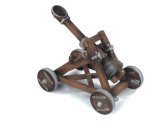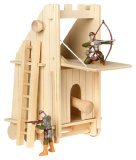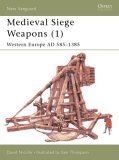Siege Engines and Weapons
 The Catapult was one of the earlies siege weapons. It hurled objects at castles and brought down castle walls. Schleich Catapult
The Catapult was one of the earlies siege weapons. It hurled objects at castles and brought down castle walls. Schleich Catapult
What is a siege weapon ?
To understand what a siege weapon, or siege engine was we first have to understand what a siege was.
A siege is the act of an army surrounding an enemy castle or fortification with the intent of keeping everyone inside for a long period of time. This siege could last months or even years. The intent of the sieging army was to starve out the people and cause their situation to become desperate so that they would surrender.
But sieges could take a very long time
If the people being sieged had lots of supplies they could potentially withstand a siege for months or even years and this long standoff was very difficult to maintain for the sieging army. It meant they could be away from their homeland and families for months or years. Attacking armies needed a way to speed up the process of the siege.
Enter the Siege Engines
What do you do if the army you are attacking is solidly defended behind large stone walls with lots of food. Do you just play the waiting game and hope that their resolve runs out before your resolve does? No, you devised ways to still attack the people inside and to bring down the massive stone walls that defended them. And this is what siege engines did. they attacked the people inside the fortifications and directly attacked the walls of the fortification. This would hopefully, bring the siege to a quicker and more favorable end for the attackers.
The Types of Siege Engines: There were many different types of siege engies but three were the most widely used and the most popular.
 The Battering Ram: In the early centuries this was a large object like the trunk of a tree that was used to break down the doors of a castle or keep. Larger ones were also used to directly attack the stone walls of the keep. These battering rams were often part of a structure called a siege tower. The siege tower was a fortifed building on wheels that could be rolled up against the walls of the castle under siege. Inside the building was the battering ram that would attack the walls. The toy shown here is a battering ram inside a siege tower.
The Battering Ram: In the early centuries this was a large object like the trunk of a tree that was used to break down the doors of a castle or keep. Larger ones were also used to directly attack the stone walls of the keep. These battering rams were often part of a structure called a siege tower. The siege tower was a fortifed building on wheels that could be rolled up against the walls of the castle under siege. Inside the building was the battering ram that would attack the walls. The toy shown here is a battering ram inside a siege tower.
 The Catapult: In the early middle ages this was a siege machine that could haul all sorts of object both directly at the castle walls and over the castle walls at the people within. The catapult, although popular in modern times was not so popular in medieval times. It took a lot of resources to build and was very heavy. It was often built in the attacking armies homeland then transported to the place of the siege.
The Catapult: In the early middle ages this was a siege machine that could haul all sorts of object both directly at the castle walls and over the castle walls at the people within. The catapult, although popular in modern times was not so popular in medieval times. It took a lot of resources to build and was very heavy. It was often built in the attacking armies homeland then transported to the place of the siege.
 The Trebuchet: In the late middle ages the trebuchet came to the forefront as the weapon of choice for sieging castles. It was easier to build and could hurl larger objects for further distances. The fact that it was easy to build meant that an attacking army didn't have to make it at home then transport it to the sieged castle. They could arrive at the place of the siege and build it with materials found at that site. The cover of this book shows a Trebuchet.
The Trebuchet: In the late middle ages the trebuchet came to the forefront as the weapon of choice for sieging castles. It was easier to build and could hurl larger objects for further distances. The fact that it was easy to build meant that an attacking army didn't have to make it at home then transport it to the sieged castle. They could arrive at the place of the siege and build it with materials found at that site. The cover of this book shows a Trebuchet.
Siege weapons were only one resource that an army had when sieging a castle or fortification. Here were some of the other methods that were used to assault and bring down a castle:
- Deception: Spies were used to infiltrate the castle. They could, at night, open the castle gates or wreak havoc on the interior defenses of the castle. The most famous case of this tactic is the Trojan Horse.
- Treachery: Someone trusted within the power structure of the castle could give misleading information that would bring down the castle. He could for example report that there were many more troops sieging the castle than there actually were. This would induce the castle residents to either revolt or surrender out of fear.
- Starvation: This was a method used but it often meant many months, sometimes even a year or more. The sieging army would station itself around the castle and not allow any form of commerce. Eventually the inhabitants would surrender due to imminent starvation.
- Biological warfare: Yep that's right. A sieging force could launch the remains of rotting corpses into the castle causing outbreaks of life-threatening illness.
- Simple storm: The sieging force could carry on an all out attack at various points of the castle. This overwhelming would hopefully break through in some places causing a collapse in defenses.
- Mining: The sieging army would actually dig tunnels under the castle. The hope was not so much for an entry into the castle but for a way to collapse the castle defenses.
Counter Measures that Castles Took in defense against sieges
- Stronger and thicker walls were built. These walls could sustain more punishment from siege engines.
- Concentric walls were built around the castle. This made it more difficult for siege engines to hurl objects at the castle. If the outer wall was breached the siege engines had to be brought inside these walls in order to attack the inner walls. This made them very vulnerable to attack.
- Moats were built: A moat was a body of water that surrounded a castle. It served the purposes of making it difficult for enemy troops, enemy siege towers and enemy battering rams to get close to the castle walls. It also made it near impossible for the sieging army to dig a tunnel under the castle.
- Higher castle towers were built. It was a great advantage to have the castle towers higher than the siege towers that attacked. They could fire down on the enemy.
Want to make your own miniature siege engine? Maybe you can't make a massive castle wall shattering siege weapon like the ones they had in the middle ages, but you can build a smaller table-top version.
 The Table Top Troll Catapult project - This is a nice project where you learn how to make a catapult from simple materials. It is powered by rubber bands.
The Table Top Troll Catapult project - This is a nice project where you learn how to make a catapult from simple materials. It is powered by rubber bands.
The Catapult Project
 The Little Dragon Trebuchet project - This is an easy project. It shows you how to make a trebuchet. This was a popular siege engine because it was easy to buildn and this is exactly why you might want to give it a try - it is easy to build but boy it can hurl projectiles!
The Little Dragon Trebuchet project - This is an easy project. It shows you how to make a trebuchet. This was a popular siege engine because it was easy to buildn and this is exactly why you might want to give it a try - it is easy to build but boy it can hurl projectiles!
The Little Dragon Trebuchet
Resources to learn more






 The Table Top Troll Catapult project - This is a nice project where you learn how to make a catapult from simple materials. It is powered by rubber bands.
The Table Top Troll Catapult project - This is a nice project where you learn how to make a catapult from simple materials. It is powered by rubber bands. The Little Dragon Trebuchet project - This is an easy project. It shows you how to make a trebuchet. This was a popular siege engine because it was easy to buildn and this is exactly why you might want to give it a try - it is easy to build but boy it can hurl projectiles!
The Little Dragon Trebuchet project - This is an easy project. It shows you how to make a trebuchet. This was a popular siege engine because it was easy to buildn and this is exactly why you might want to give it a try - it is easy to build but boy it can hurl projectiles!